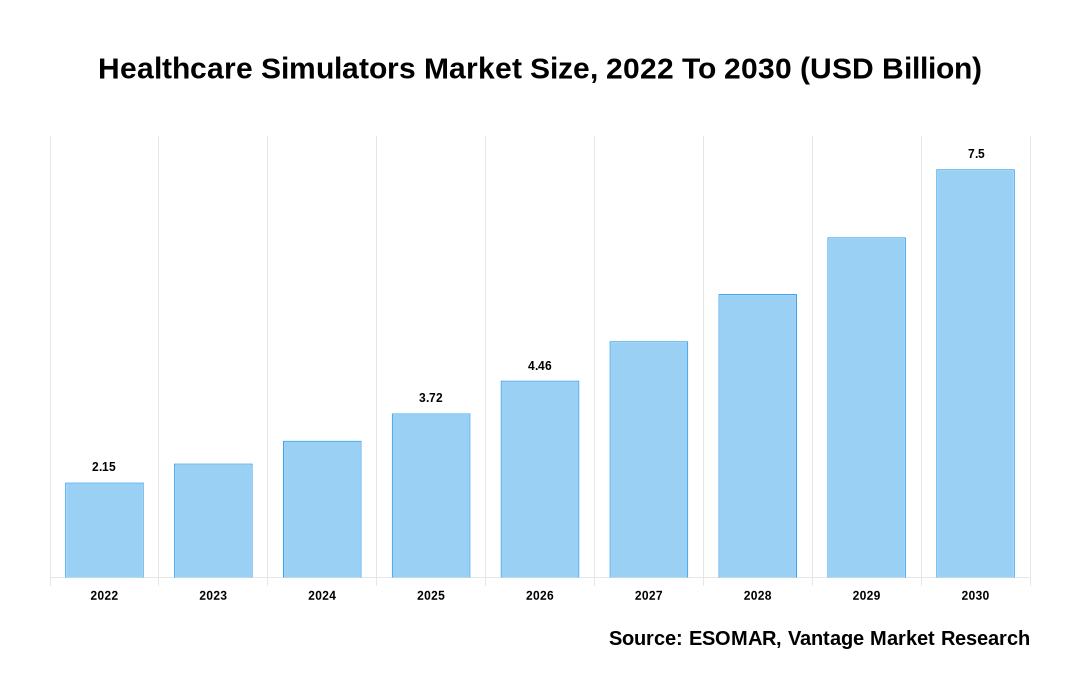Global Healthcare Simulators Market
As stated in our extensive report, the Global Healthcare Simulators Market accounted for USD 2.15 Billion in 2022 and is projected to reach a value of USD 7.5 Billion by 2030.
The Healthcare Simulators market is a growing industry that provides simulation-based training solutions to healthcare professionals. These simulators are designed to replicate real-life situations and give healthcare professionals hands-on experience in various medical scenarios. The Healthcare Simulators market is driven by the increasing demand for patient safety and the need to improve the quality of healthcare delivery. Medical errors are one of the leading causes of death and injury in the healthcare industry, and simulation-based training can help reduce these errors by enabling healthcare professionals to practice and improve their skills in a safe and controlled environment.
The market is also driven by technological advancements, particularly in virtual and augmented reality, making simulators more realistic and engaging. The use of simulators in medical education and training is becoming increasingly common, and many medical schools and hospitals have invested in simulation centers to provide their students and staff with hands-on training. Another major factor contributing to the growth of the Healthcare Simulators market is the advancement of technology. Healthcare Simulators has become more sophisticated and realistic with innovative technologies. The incorporation of virtual reality, augmented reality, and artificial intelligence has made simulation training more immersive and compelling.
Click To Get a Free Sample On the Research Study

These are the primary factors that must be considered to propel the growth of the global Healthcare Simulators market. However, the high cost of simulators, lack of standardization and interoperability, and limited availability of skilled professionals to operate these systems are some of the major factors restraining the growth of the global Healthcare Simulators market.
Key factors influencing Healthcare Simulators Market Growth
The growth of the global Healthcare Simulators market can be attributable to the following:
- Healthcare Simulators offer immersive training experiences that can help surgeons and other healthcare professionals master the skills needed to carry out minimally invasive surgeries. As such, the rising demand for such procedures is expected to drive market growth.
- The development of advanced simulators that can mimic realistic patient scenarios is expected to boost the adoption of Healthcare Simulators. This can enhance the quality and effectiveness of simulation-based training programs, leading to better patient outcomes.
- The healthcare industry is becoming increasingly focused on patient safety, and Healthcare Simulators can play a vital role in ensuring it. Simulated training allows healthcare professionals to practice and refine their skills safely, reducing the risk of errors during real-life procedures.
- Simulation-based training is being increasingly used in medical education to improve the skills of students and residents. This is expected to increase the demand for Healthcare Simulators, driving market growth.
- Traditional training methods such as on-the-job training and apprenticeships are often expensive and risky for patients. Healthcare Simulators offer a cost-effective and safe alternative, which can help to reduce overall training costs.
- The shortage of healthcare professionals in many parts of the world drives the need for more efficient training methods, such as simulation-based training. Using Healthcare Simulators can increase the speed and effectiveness of training, helping to mitigate the impact of the shortage.
- Healthcare professionals must continually maintain and improve their skills to provide the best possible care to patients. Healthcare Simulators offer a way to do this, providing ongoing opportunities for learning and development.
- Governments worldwide are increasingly investing in healthcare training and education. This is expected to drive market growth as Healthcare Simulators becomes essential to training programs.
North America Region to Lead the Market
North America Healthcare Simulators market is getting more significant with maximum market share during the forecast period. The largest region in the Healthcare Simulators market is North America, dominated by the United States, with a market share of approximately 60%. This can be attributed to the high adoption rate of advanced healthcare technologies, high healthcare expenditure, and a large pool of aging population in the region. Moreover, the presence of major market players such as CAE Healthcare, Laerdal Medical, and Simulaids in North America further boosts the growth of the Healthcare Simulators market in the region. In addition, the increasing focus on patient safety and the rising demand for simulation-based medical training are also driving the market’s growth in North America.
Furthermore, the COVID-19 pandemic has led to increased adoption of Healthcare Simulators as many medical institutions have shifted towards virtual training and education, which has further fueled the growth of the Healthcare Simulators market in the region.
Conclusion
The global market for Healthcare Simulators is proliferating due to the rising concern for patient safety and the desire to raise the standard of healthcare delivery. Solutions for simulation-based training provide practical experience in a secure and monitored setting, lowering the risk of mistakes and improving patient outcomes. Technology developments like virtual and augmented reality have increased the realism and efficiency of simulators, spurring market expansion. Despite difficulties like high costs and a lack of skilled workers, the market is being driven forward by increased demand for minimally invasive surgeries, government funding, and the switch to virtual training during the COVID-19 epidemic.
Some of the key players in the Global Healthcare Simulators Market include- 3D Systems (U.S.), CAE (Canada), Cardionics Inc. (U.S.), Gaumard Scientific Company (U.S.), Kyoto Kagaku (Japan), Laerdal Medical (Norway), Limbs & Things (UK), Medaphor (UK), Mentice AB (Sweden) and others.
![[Market Research Reports] – Research Google News Blog | VMR.Biz](https://www.vmr.biz/wp-content/uploads/2022/12/logo-removebg-preview.png)











